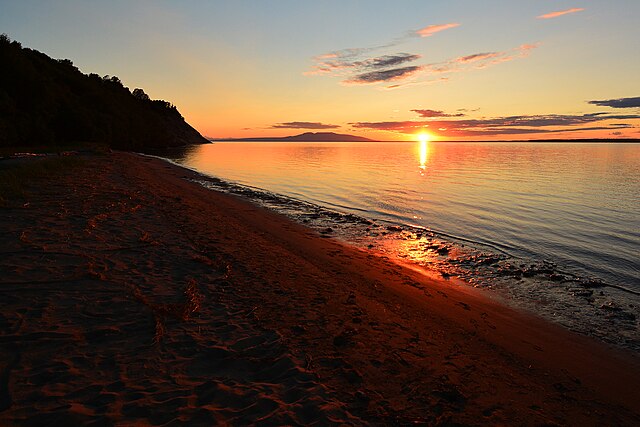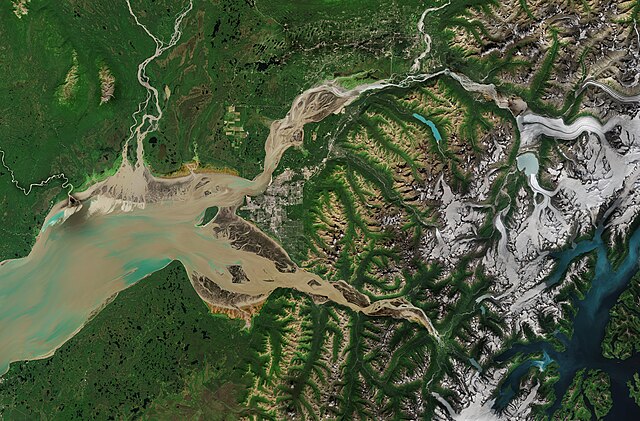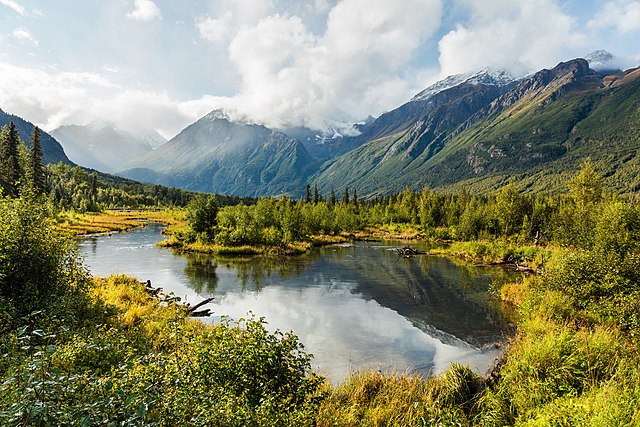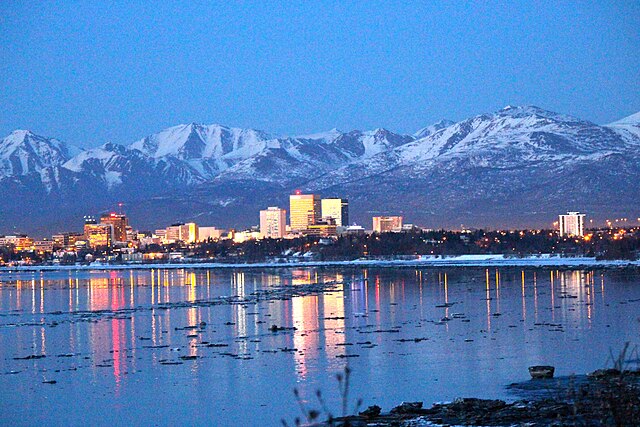Have you ever wondered what it’s like to experience weather that shifts as quickly as a mood swing? Welcome to Anchorage, Alaska, where the weather is as dynamic as the city itself. Nestled between the Chugach Mountains and the Pacific Ocean, Anchorage boasts a climate that’s both mild and unpredictable. From sunny summer days that stretch into twilight to snowy winters perfect for aurora gazing, the weather here keeps you on your toes. In this guide, we’ll dive into what makes Anchorage’s weather tick, how it shapes life in the city, and how you can prepare for its quirks. Ready to explore the wild and wonderful world of Anchorage weather? Let’s get started!
Understanding Anchorage’s Unique Climate
Anchorage’s climate is like a symphony—complex, with different movements that blend into a harmonious whole. Protected by the Chugach Mountains and warmed by Pacific Ocean currents, the city enjoys a milder climate than you’d expect for a place so far north. Unlike the bone-chilling cold of interior Alaska, Anchorage’s winters hover around the mid-20s°F (-5°C), while summers climb into the low 70s°F (20s°C). But don’t let those averages fool you—Alaska’s weather is notorious for changing faster than you can say “moose crossing.”
What Influences Anchorage’s Weather?
Several factors play a role in Anchorage’s weather patterns. The city’s proximity to the ocean moderates temperatures, preventing the extreme cold you’d find in places like Fairbanks. The Chugach Mountains act like a shield, blocking some of the harsher weather systems from the interior. Then there’s the jet stream, which can swing warm or cool air into the region like a pendulum. Add in the occasional wildfire smoke from Canada or volcanic ash from nearby peaks, and you’ve got a weather recipe that’s as wild as an Alaskan grizzly.
Seasonal Breakdown of Anchorage Weather
Anchorage’s weather is a four-season adventure, each with its own personality. Whether you’re chasing the midnight sun or hoping to catch the Northern Lights, understanding the seasons is key to planning your visit. Let’s break it down season by season.
Summer: Long Days and Mild Temperatures

Summer in Anchorage is like a dream that never ends—literally. With up to 19 hours of daylight in June, the sun barely dips below the horizon, creating a phenomenon called the midnight sun. Temperatures range from 50°F to 70°F (10°C to 20°C), making it perfect for hiking, fishing, or just soaking up the rays on a sun-soaked deck. But don’t pack away your raincoat—August brings about 3 inches of rain, and showers can pop up like uninvited guests. Layers are your best friend here, as mornings can be chilly, while afternoons feel like a warm hug.
Tips for Summer Visitors
Planning a summer trip to Anchorage? Pack lightweight layers and a good pair of sunglasses to handle the bright, long days. Don’t forget sunscreen—those extended daylight hours can sneak up on your skin. If you’re hitting the trails or taking a glacier cruise, waterproof shoes and a rain jacket are must-haves. The weather might be mild, but it’s as changeable as a chameleon.
Fall: A Fleeting Burst of Color
Fall in Anchorage is like a painter’s palette, with vibrant reds, oranges, and yellows blanketing the landscape. September and October see temperatures drop to 45°F to 55°F (6°C to 13°C), with occasional showers adding a misty charm. By late fall, you might even spot snowflakes dancing in the air. This season is perfect for those who love fewer crowds, cheaper travel deals, and the chance to see the Northern Lights as the nights grow longer.
Packing for Fall Adventures
Fall weather can be as unpredictable as a plot twist in a thriller novel. Pack a mid-weight coat, warm sweaters, and thermal layers to stay cozy. A waterproof jacket is non-negotiable, as September averages about 3 inches of rain. If you’re hoping to catch the aurora, bring a warm hat and gloves for those chilly night-time stakeouts.
Winter: Snowy Days and Northern Lights
Winter in Anchorage is a wonderland straight out of a postcard. From October to April, snow blankets the city, with temperatures ranging from 13°F to 25°F (-10°C to -5°C). While that might sound cold, it’s mild compared to other parts of Alaska. The city sees about 70 inches of snow annually, perfect for skiing, snowshoeing, or building a snowman. The short days—sometimes just seven hours of daylight—set the stage for spectacular Northern Lights displays. Imagine sipping hot cocoa while the sky dances with green and purple ribbons. Magical, right?
Winter Weather Challenges
Winter weather can throw curveballs, like icy roads or sudden snowstorms. If you’re driving, make sure your vehicle is winter-ready with snow tires and an emergency kit. Dress in layers—think thermal underwear, fleece pullovers, and a heavy parka. And don’t skimp on the boots; waterproof ones with good traction are your best bet for navigating snowy sidewalks.
Spring: A Season of Renewal
Spring in Anchorage is like waking up from a long nap. As the snow melts and days lengthen, temperatures climb from 32°F to 50°F (0°C to 10°C). April and May bring a mix of sunny days, muddy trails, and the occasional rain shower. It’s a quieter time to visit, with locals shaking off the winter blues and wildlife starting to stir. If you’re into birdwatching or want to see baby moose, spring is your season.
Spring Packing Essentials
Spring weather is as fickle as a cat—sunny one minute, rainy the next. Pack versatile clothing like moisture-wicking base layers, a fleece jacket, and a waterproof outer layer. Sturdy hiking boots are a must if you’re exploring the thawing trails. And don’t forget a good pair of sunglasses—the snow’s glare can be intense as it melts under the strengthening sun.
Day-to-Day Weather Patterns in Anchorage

Anchorage’s weather is like a box of chocolates—you never know what you’re gonna get. One day might start with clear skies, only to turn cloudy by lunch. Recent reports show temperatures in late June 2025 hovering around 57°F to 63°F, with overcast skies and a 20-30% chance of rain. Humidity levels sit at 59-69%, and winds blow gently at 5-10 mph. These conditions reflect Anchorage’s typical summer vibe: cool, cloudy, and just a tad damp.
Current Weather Snapshot
As of June 22, 2025, Anchorage is experiencing overcast skies with temperatures around 57°F, 69% humidity, and light winds at 6 mph. The pressure is steady at 1012 mb, suggesting stable but cloudy conditions. If you’re in town today, expect a cool, gray day—perfect for a cozy coffee shop visit or a scenic drive along the Turnagain Arm.
How Weather Shapes Life in Anchorage
The weather in Anchorage isn’t just something to talk about—it’s a way of life. Locals embrace the seasons with enthusiasm, whether they’re hitting the slopes in winter or kayaking in summer. The city’s infrastructure is built to handle snow and ice, with plows keeping roads clear and heated sidewalks in downtown areas. But the weather also brings challenges, like the occasional bear breaking into a chicken coop during a stormy night, as one resident shared on social media. It’s all part of the Alaskan adventure.
Outdoor Activities and Weather
Anchorage’s weather sets the stage for a playground of outdoor activities. Summer’s long days are ideal for hiking in Chugach State Park or fishing in Ship Creek. Winter brings opportunities for skiing at Alyeska Resort or dog sledding under the stars. But always check the forecast—sudden rain or snow can turn a fun outing into a soggy mess. Apps like AccuWeather or The Weather Channel are your go-to for real-time updates.
Weather-Related Risks and Precautions
While Anchorage’s weather is generally mild, it’s not without its quirks. Wildfire smoke from Canada can drift in during summer, affecting air quality. Thunderstorms, though rare, can spark wildfires, as seen in recent years. Winter storms can dump heavy snow, making travel tricky. Always have a plan B, whether it’s an indoor museum visit or a backup route for your road trip. And if you’re venturing into the backcountry, let someone know your plans—Mother Nature doesn’t mess around.
Staying Safe in Anchorage’s Weather
Safety is key when dealing with Anchorage’s weather. In summer, watch for sudden rain showers that can make trails slippery. In winter, bundle up to avoid frostbite, and keep an eye on avalanche warnings if you’re hitting the slopes. Always carry a small emergency kit with essentials like a flashlight, first-aid supplies, and extra layers. It’s like having an insurance policy for your adventure.
Planning Your Visit Around Anchorage’s Weather

Timing your visit to Anchorage is like picking the perfect moment to jump into a double-dutch game—it takes a bit of strategy. Summer (June to August) is peak season, with warm weather and endless daylight. Fall (September to October) offers stunning colors and fewer tourists. Winter (November to March) is for snow lovers and aurora chasers, while spring (April to May) is a quieter time for budget travelers. No matter when you visit, pack for all seasons and be ready to pivot if the weather throws a curveball.
Best Time to Visit Anchorage
So, when’s the best time to visit Anchorage? It depends on what you’re after. If you want warm weather and outdoor adventures, July is your sweet spot, with average highs of 67°F (19°C). For Northern Lights and winter sports, aim for January or February. If you’re on a budget, spring or fall offers great deals and fewer crowds. Just don’t expect the weather to cooperate fully—it’s got a mind of its own.
Anchorage Weather and Climate Change
Like much of Alaska, Anchorage is feeling the effects of climate change. Warmer winters are leading to more rain than snow, impacting ski resorts and wildlife patterns. Summers are seeing more extreme heat, with temperatures occasionally hitting the 80s°F. Wildfires are becoming more frequent, and melting glaciers are changing the landscape. Locals are adapting, but it’s a reminder that Anchorage’s weather is part of a bigger global story.
How to Stay Informed About Anchorage Weather
Keeping tabs on Anchorage’s weather is as easy as checking your phone. The National Weather Service (weather.gov) offers detailed forecasts, while apps like AccuWeather and The Weather Channel provide hourly updates. Local sources like Alaska’s News Source (alaskasnewssource.com) cover weather alerts and regional trends. For real-time vibes, check X posts from accounts like @NWSAnchorage or @_AnchorageAK for the latest conditions. Knowledge is power when it comes to navigating Alaska’s weather.
Conclusion
Anchorage, Alaska, is a city where the weather is as much a part of the experience as the mountains and fjords. From the endless daylight of summer to the snowy charm of winter, each season offers something unique. Whether you’re planning a hiking trip, a ski adventure, or a cozy aurora-watching getaway, understanding Anchorage’s weather is your ticket to a memorable visit. So, pack your layers, keep an eye on the forecast, and embrace the unpredictability. Anchorage’s weather might keep you guessing, but that’s just part of its wild, untamed charm. Where will your Alaskan adventure take you?
FAQs About Anchorage Weather
1. What is the best time of year to visit Anchorage for warm weather?
July is the warmest month, with average highs around 67°F (19°C). It’s perfect for outdoor activities like hiking and fishing, but pack a rain jacket for occasional showers.
2. How much snow does Anchorage get in winter?
Anchorage sees about 70 inches of snow annually, with the heaviest snowfall from December to February. It’s ideal for winter sports but requires proper gear for safety.
3. Can I see the Northern Lights in Anchorage?
Yes, winter months (November to March) offer the best chances to see the Northern Lights, especially on clear, dark nights. Head to areas with low light pollution for the best views.
4. How do I prepare for Anchorage’s unpredictable weather?
Dress in layers, pack waterproof clothing, and always have a backup plan for outdoor activities. Check local weather apps like AccuWeather or the National Weather Service for updates.
5. Does Anchorage’s weather affect air travel?
Winter storms and heavy snow can cause flight delays, so check with your airline and allow extra time. Summer weather is generally more stable but can still bring surprises.

